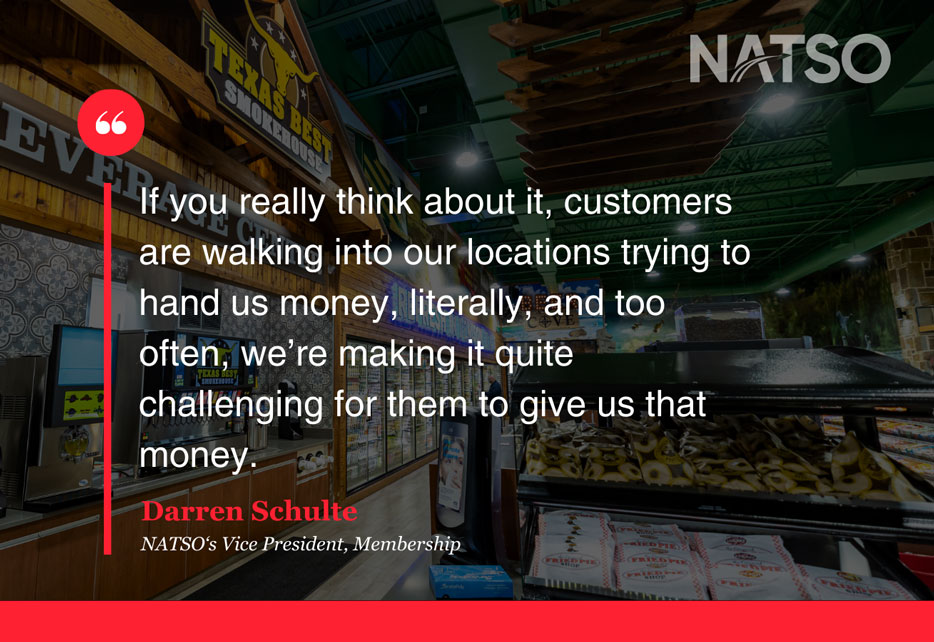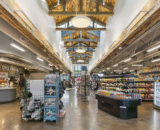Article created for the digital issue of the NATSO Foundation’s
Travel centers are seeing increased competition from c- stores and non-retail companies that are catering to professional drivers, making it more important than ever for operators to get to know their customers, leverage their behavior and provide more to those who are already stopping.
“We have to return back to the days where we’re focusing on wallet share,” said Darren Schulte, NATSO’s vice president of membership. “We’ve got them on our property. How do we get more money out of that pocket while they’re on our space?”
The key, Schulte said, is to make it easy for customers and eliminate all of the obstacles that are making it difficult for them to buy.
Schulte and Christine Schoessler, NATSO’s chief operating officer, shared opportunities for growing revenue during a NATSO webinar. As part of their discussion, they shared the results from NATSO Services’ latest survey of professional drivers along with insights from hundreds of location visits and targeted, one-on-one driver interviews.
Schoessler said all of the research has shown there are significant growth opportunities for travel center operators, making this an exciting time for operators to provide the experience and services today’s drivers want.
Increasing Inside Sales
In the survey, a significant number of drivers—81%—said that they’d gone into a travel center and left without purchasing food or beverages. Schulte encouraged operators to think of that as 20 out of 100 customers typically buy something and asked them to consider what the financial impact would be if they just moved that to 30.
The No. 1 reason drivers said they didn’t make a purchase was because they just came in to use the restroom or shower. “You’ve got an opportunity there whether it is an impulse buy or something else,” Schoessler said.
The second highest reason was because the wait times were too long. “I think that’s interesting, because once you know what the challenge is, then you can start figuring out how to overcome it,” Schoessler said, noting that speed has become table stakes in today’s operating environment.
Among respondents, 58% said they’re only willing to wait in line during driving hours less than five minutes and 3% said they wouldn’t wait in line at all. “When we switched it up a little bit and said, ‘how many people do you need to see in line before you leave without making a purchase,’ 13% said they would leave without purchase if there was just two people in line,” Schoessler said.
Making It Personal
Locations can look for ways to speed the process up for drivers, such as automated retail, increased availability of grab-and-go items or self-checkouts. However, Schulte said there is a balancing act between automation and human interaction. “I think we first, as operators, have to understand it’s not going to be a reduction in labor. It’s going to be a redeployment of your labor,” he said.
That may mean that if there were three cashiers behind the counter, now there are two behind the counter and one at self-checkout helping customers.
Operators also need to know their customers, which will help determine which speed-saving solutions are the most appropriate.
Building Loyalty
One of the other important pieces that came out of the NATSO Services survey, which was also underscored in the interviews with drivers, was the importance of loyalty programs. Within the survey, 54% of the respondents said they’ve actively considered loyalty programs when deciding whether to go inside where they’ve stopped for fuel.
“That’s directly related to building your wallet share,” Schoessler said. “How do you get them to come in and do something in addition to that fuel transaction? The only factor that scored higher than loyalty was cleanliness.”
Featuring Food
Food is an important selling point for drivers, and about half of drivers said they are looking for speed when deciding where to stop for food. Faster options that appealed to drivers in the survey included fast food, a quick-service-restau- rant chain or fresh grab-and-go.
Schoessler said about one-third of drivers said they’re looking for a full- service family-style restaurant. “I think this comes down to know exactly who your customer is and which one fits them,” she said.
Fuel efficiency has increased, and the length of haul has decreased, which has implications for the amenities today’s drivers want. “What types of food programs are you offering that can make a difference? And more importantly, does it give you the ability to try different types of food programs?” We have members sharing data with us that sushi out of their cold box is one of their best sellers,” Schulte said.
// This article was created for Stop Watch magazine, the magazine of the NATSO Foundation. The NATSO Foundation is the research, education and public outreach subsidiary of NATSO, Inc. The NATSO Foundation provides programs and products to strengthen travel plazas’ ability to meet the traveling public's needs through improved operational performance and business planning. Visit www.natsofoundation.org for more information. (Donate to the NATSO Foundation here.)
Subscribe to Updates
NATSO provides a breadth of information created to strengthen travel plazas’ ability to meet the needs of the travelling public in an age of disruption. This includes knowledge filled blog posts, articles and publications. If you would like to receive a digest of blog post and articles directly in your inbox, please provide your name, email and the frequency of the updates you want to receive the email digest.







